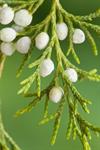| Family | Scientific Name | Common Name | Habitat | Distribution | Image |
|---|---|---|---|---|---|
| Cupressaceae | Juniperus ashei | Ashe Juniper, Rock Cedar, Ozark White-cedar | Exposed calcareous bluffs and glades, usually on very steep slopes atop cliffs or on flat glades with much exposed bedrock. | S. MO, AR, and OK south to TX (especially the Edwards Plateau) and adjacent Mexico (COA, NLE). |  |
| Cupressaceae | Juniperus communis var. communis | European Common Juniper | Forests, fens, pastures, disturbed areas. | Native of Eurasia. |  |
| Cupressaceae | Juniperus communis var. depressa | Ground Juniper, Mountain Juniper, Common Juniper | In thin soil around rock outcrops on mountain summits and Piedmont monadnocks and rocky bluffs (in GA and NC), high elevation old fields (in VA), xeric Coastal Plain sandhills (in SC and VA). | Juniperus communis is circumpolar, widespread in n. North America, n. Europe, and n. Asia. Adams (2008a, 2008b, 2008c, 2018) recognizes five varieties in North America, all native eastern North American plants belonging to var. depressa. In North America J. communis s.l. is primarily northern and montane, occurring nearly throughout Canada and AK, south in the Appalachians to SC, GA, and AL, south in the Rocky Mountains to NM, AZ, and CA. It is sometimes planted as a landscaping plant. In e. North America, it is rare and scattered south of PA, MI, and WI, ranging south to a few disjunct sites in VA, NC, SC, GA, and s. IN, in our area notably known from Mount Satulah (Macon County, NC), King's Pinnacle (Gaston County, NC), and in sandy soils at Hitchcock Woods (Aiken County, SC). |  |
| Cupressaceae | Juniperus conferta | Japanese Shore Juniper | Roadsides. | Native of Japan. Reported as naturalizing in AL (Barger, et al. 2012). Also reported for MA. |  |
| Cupressaceae | Juniperus horizontalis | Creeping Juniper | Sand dunes. | NL west to AK, south to NY, n. OH, nw. IN, IL, IA, NE, WY, MT, and BC. A record from Long Island appears to be a false report. | |
| Cupressaceae | Juniperus ovata | West Texan Ashe Juniper | Limestone outcrops and calcareous gravels. | Primarily in w. TX and COA, but also apparently isolated near New Braunfels (Adams 2008d). |  |
| Cupressaceae | Juniperus pinchotii | Redberry Juniper | Gravelly and sandy outcrops. | C. and w. OK south to c. TX, s. TX (Duval County), s. NM to Mexico (CHI, COA, DUR, NLE). |  |
| Cupressaceae | Juniperus silicicola | Southern Red Cedar, Coastal Red Cedar | Maritime forests and maritime scrub, hammocks, coastal shell middens and natural shell deposits, brackish marshes, pine rocklands in s. FL, and other sandy or peaty, circumneutral situations. | Se. VA (?) south to s. FL, west to e. LA (Florida Parishes); reports from further west (e.g. TX) are misidentifications. VA records are ambiguous (see Virginia Botanical Associates 2023). |  |
| Cupressaceae | Juniperus virginiana | Eastern Red Cedar | Bluffs, glades, upland forests and woodlands, pastures, old fields, roadsides, and fencerows, primarily upland, occurring most abundantly on (but by no means restricted to) circumneutral soils (including shrink-swell clays) derived from mafic or calcareous rocks. | S. ME west to e. ND, south to n. FL, s. AL, s. MS, s. LA, and c. TX; disjunct in Coahuila, Mexico (Adams 2011). |  |
Cite as...